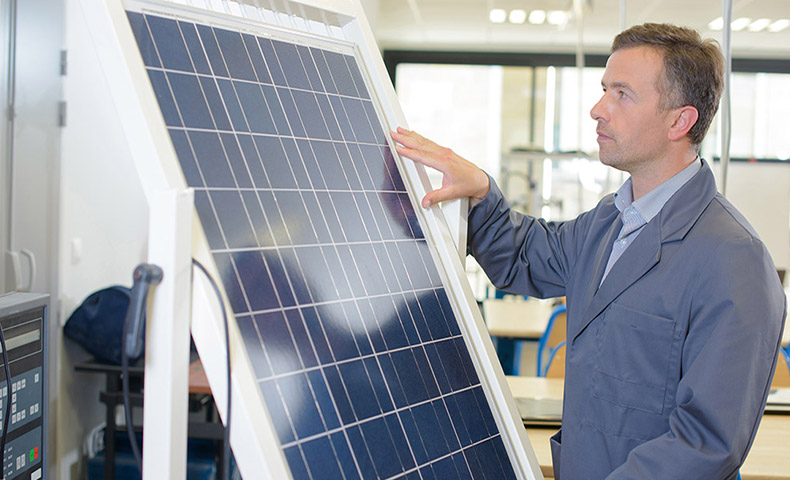
They generate electricity without burning fossil fuels and although covered with glass and made with sensitive materials, solar panels are made to last because they are exposed to the elements and are supposed to work in all types of weather.
As more homeowners and businesses adopted green energy in recent years, electricity from solar began picking up. Nearly all solar panels currently in operation today were installed after 2009 and they are estimated to produce at least 80% of their rated power output for the next 30 years.
According to Greenmatch, during the first 10-12 years of a solar panel, power capacity will decrease about 10 percent, going up to 20 percent when reaching 25-30 years. However, studies show that the drop out in electricity generation is only 6-8 percent after 25 years.
But what to do with them when they die?
First, let’s look at what a solar panel is made of. In the NPR podcast “Climate Cast”, San Jose State University associate environmental professor Dustin Mulvaney, explained that “about 90 percent of a solar panel is glass.”
As such, they can be damaged or destroyed by natural disasters. Think of the recent hurricanes in Houston, Florida and Puerto Rico that wreck havoc on solar panel installations.
Once their life is over, solar panels become waste that should be recycled.
Mulvaney said in the podcast that glass can be salvaged as "float glass" for other uses, like in windows.
But the higher-value recycling is in the silver and aluminum, elements that compose the remaining 10% of what makes up a solar panel.
Panels can have also have a resale value, as they can still generate some electricity after their lifespan under warranty, they just aren't as efficient as when they're newer. Some people will use old panels for low-lift jobs requiring smaller amounts of power
Right now, the recycling efforts around solar panels is minimum; scientists pose the bigger problem will be in 15 years.
The International Renewable Energy Agency (IRENA) in 2016 estimated there was about 250,000 metric tonnes of solar panel waste in the world at the end of that year. IRENA projected that this amount could reach 78 million metric tonnes by 2050.
Recycling the old solar panels
Solar cells manufacturers are bound by law to fulfill specific legal requirements and recycling standards in order to make sure that solar panels do not become a burden to the environment. This is especially important because while minimal, solar cells do include toxic chemicals. However, tests conducted on these panels reveal levels of toxic chemicals far beneath the standards of the Environmental Protection Agency (EPA).
The California Department of Toxic Substances Control (DTSC) indicates solar panel waste includes heavy metals such as silver, copper, lead, arsenic, cadmium, selenium that at certain levels may be classified as hazardous wastes.
"Whether broken or intact, hazardous waste solar panels must be managed according to the hazardous waste regulations. Hazardous waste solar panels that are broken or cracked and not usable must be managed as hazardous waste. Broken pieces must be cleaned up and properly packaged/containerized as to minimize the potential release. Containers shall be structurally sound and prevent releases under reasonably unforeseeable conditions. When using a spill kit, follow the manufacturer’s instructions. A generator who fails to respond to a spill or release within a timely manner may be cited," DTSC explains.
Solar panels often contain lead, cadmium, and other toxic chemicals that cannot be removed without breaking apart the entire panel. For this reason, the whole solar panel is considered hazardous by many experts and governments, including the state of California, which is trying to prevent the flow of old solar panels to landfills.
The state of Washington became the first U.S. state to require manufacturers selling solar panels to have a plan to recycle.
If you discover that one of the solar panels installed in your home is no longer working, you should call your installer immediately to check it and, if necessary, replace it. The warranty should cover this replacement.
The California DTSC describes that non-hazardous waste such as glass, copper wire and aluminum framing from the non-hazardous solar panels can be taken to a non-hazardous landfill or to recycling centers to be disassembled and reclaimed for value through recycling activities.
You may ask your solar energy installer how they will dispose of the solar panel. Whether through recycling or other means.
In the United States, the law that governs solar panel disposal is called the Resource Conservation and Recovery Act (RCRA), which applies to all solid waste. Under the RCRA, it is currently legal to simply throw away solar panels like normal garbage.
However, some solar companies have instituted a specific way of getting rid of them, first putting them through a process that involves shredding, crushing, and treating the solar panels to separate the different components.
The Solar Energy Industries Association (SEIA) has also developed its own PV Recycling Working Group that chooses Preferred Recycling Partners through an evaluation process that may include a site visit. Those partners are capable of recycling PV modules, inverters and other related equipment.
Want to learn more about how to take the leap to solar? Check out the HahaSmart blog!
- Unlock The Lowest Solar Prices in Your AreaRegister Now
- See How Much You SaveCheck Your Home's Solar Price
- See Credits and Incentives in Your AreaYour Solar Incentives
- Stay InformedHahaSmart News
- More Solar Tips and GuideHahaSmart Blog


Input your address to see if it is solar friendly and how much you can save with solar.
Great. Your address is perfect for solar. Solar incentive is still available. Select monthly utility cost and calculate the size of solar system you will need now.
| kw System size | years Payback period | Lifetime savings |
No money down, 100% finance is available.
|
|
Want to design your perfect solar home? Sign up now and we'll help you |
Comments